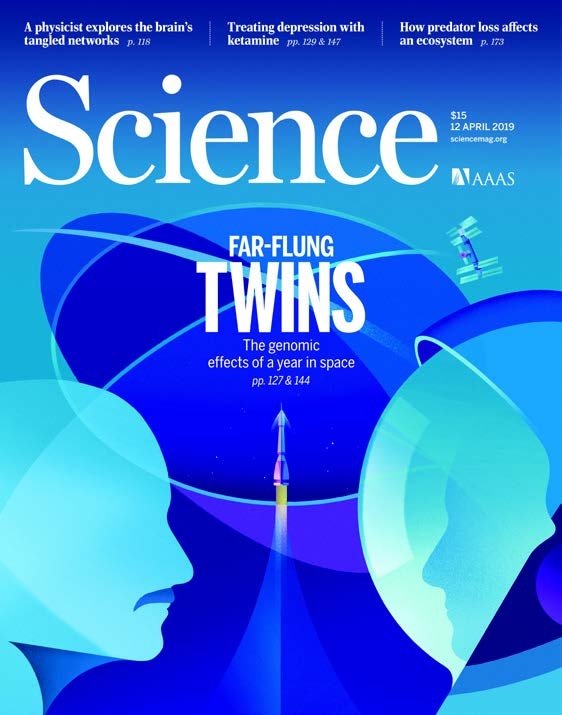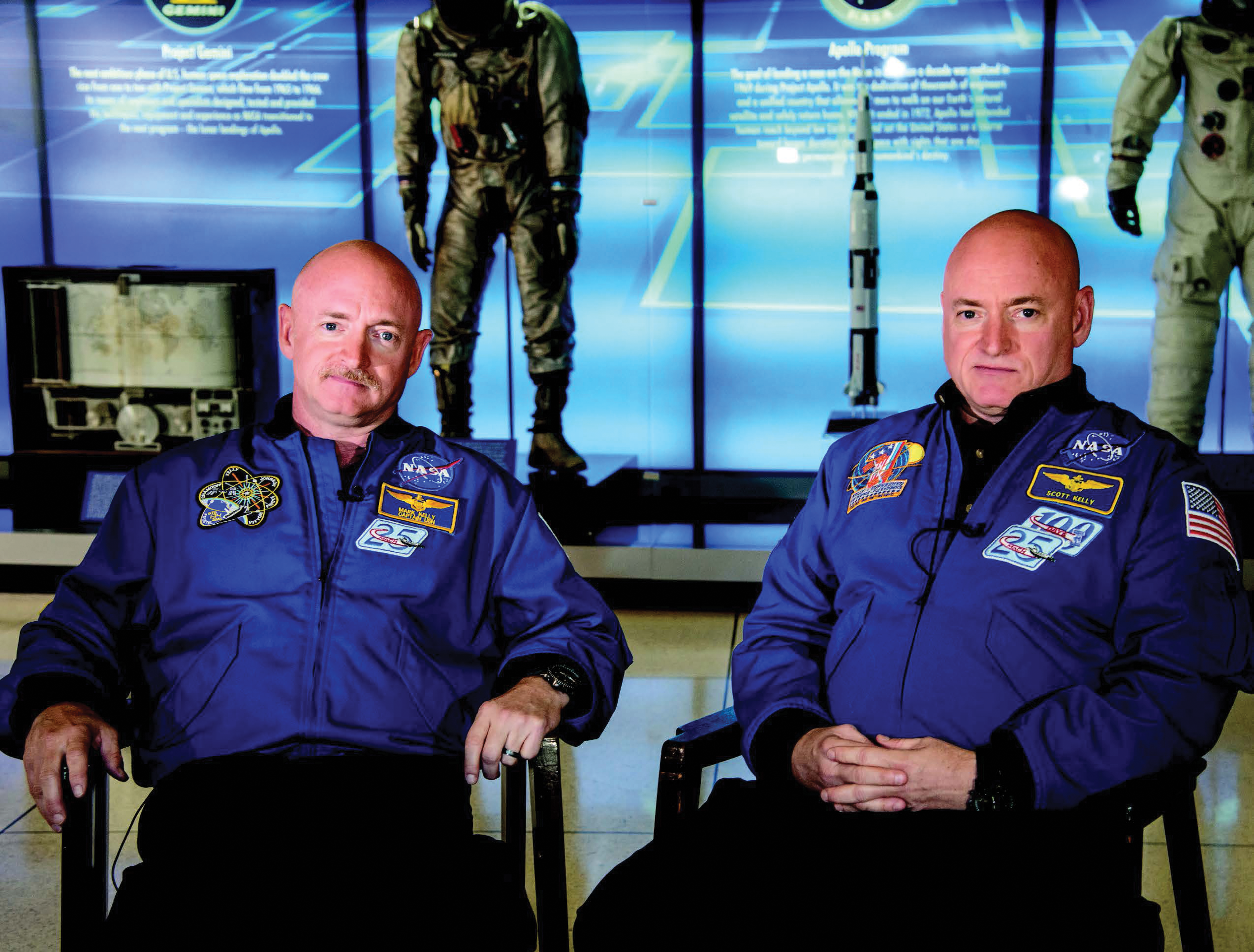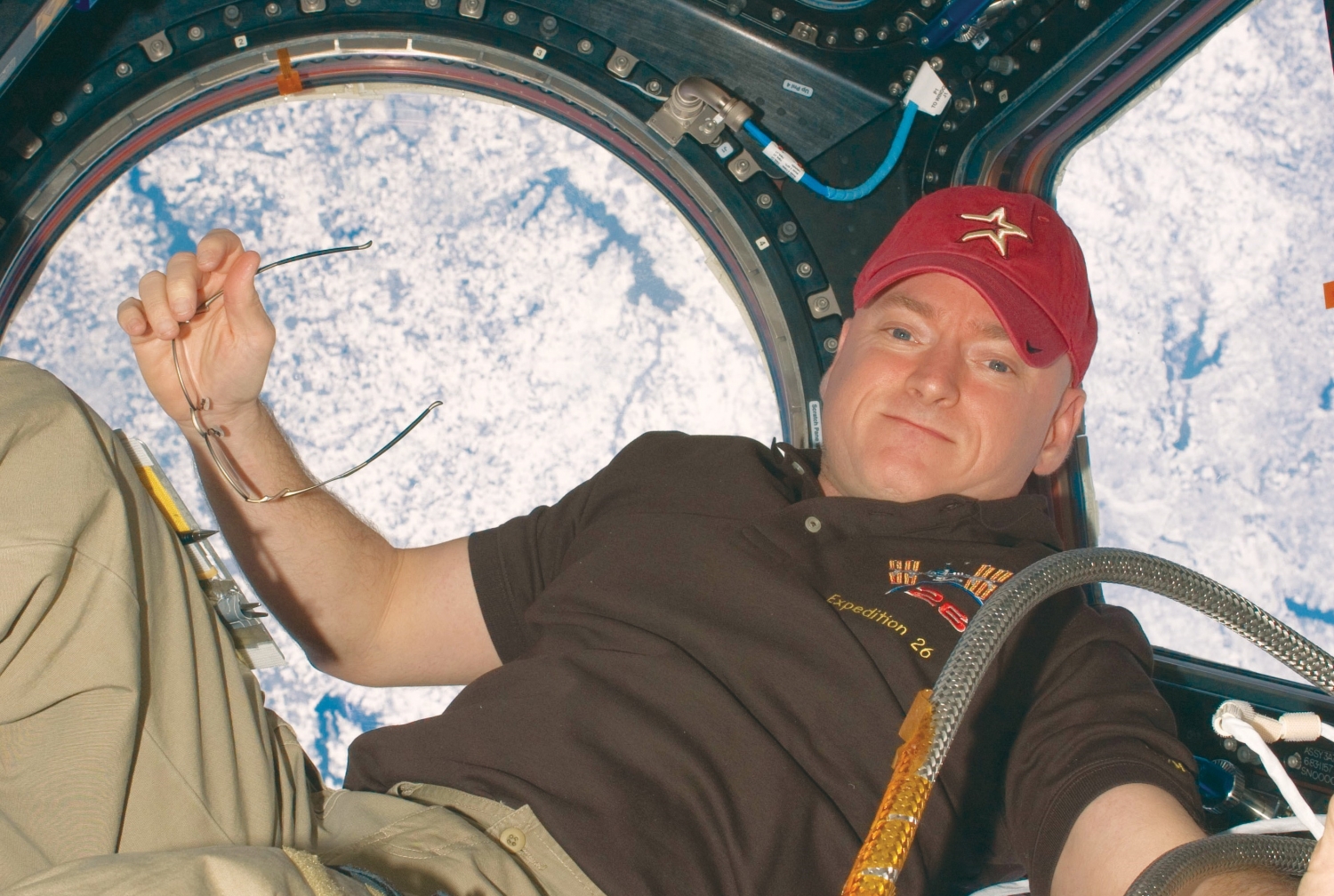It has been called the most comprehensive analysis of individual human beings ever conducted in scientific history. In March 2015, astronaut Scott Kelly rode a Soyuz spacecraft to the International Space Station and proceeded to spend 340 days in orbit as part of an in-depth study of the long-term effects of space travel on the human body. As rare and valuable as that effort was—representing the longest-ever space mission for a NASA astronaut—it was all the more remarkable thanks to a tantalizing offer from Kelly’s identical twin brother: Mark Kelly, himself a retired astronaut. Since Mark was staying on terra firma, he volunteered to serve as an experimental control, allowing scientists to compare two genetically identical men—one on Earth, the other in zero gravity some 220 miles above it, traveling at almost five miles per second.

The cover of Science featuring the Twins Study.
During Scott’s time on the space station (as well as six months before and after his mission), the brothers underwent physical and cognitive testing and contributed numerous blood, urine, saliva and fecal samples for analysis. Dubbed the NASA Twins Study, the effort comprised 10 interconnected research projects—on such topics as cognition, cardiovascular health, genomic changes, immune response, and the composition of gut, skin and oral bacteria—funded by a total of $1.5 million in agency grants and involving dozens of investigators around the country and abroad.
One of those projects, which focused on how Scott’s environment affected how his genes were expressed and regulated, was led by Weill Cornell Medicine’s Dr. Chris Mason—and along with the nine others, it would make headlines around the world. In April, the Twins Study landed on the cover of the journal Science, which featured a 20-page article summing up the results—the first publication of what’s expected to be many, as researchers continue to parse a mother lode of data. “Overall, the Twins Study is a tour de force about how the body’s adaptability extends to outer space,” says Dr. Mason, the WorldQuant Foundation Research Scholar in physiology and biophysics and an associate professor of neuroscience, of physiology and biophysics, and of computational genomics in computational biomedicine. “The vast majority of changes we saw returned to normal—but about 8 or 9% remained. So it also shows that the body was still to some degree adapting to terrestrial life, even six months after Scott Kelly returned to Earth.”
Among the Mason Lab’s findings were that thousands of genes became active in Scott while remaining dormant in Mark—an effect that became more marked the longer Scott stayed in space. Those genes included ones that play a role in repairing damaged DNA—which may reflect the fact that while in space, Scott was exposed to nearly 50 times as much radiation as his brother was on Earth. Also active were genes related to inflammation, which could be due to the inherent stresses of space travel on the human body; these include the effects of being in zero gravity, such as fluid shifts and bone loss. For Dr. Francine Garrett-Bakelman, who was the first author on the Science paper, the findings made sense. “I’m a physician-scientist, and as a physician, I thought, ‘Yes, an astronaut is under significant stress,’” says Dr. Garrett-Bakelman, who completed her research and medical postgraduate training at Weill Cornell Medicine (where she was an instructor and an assistant attending physician at NewYork-Presbyterian/Weill Cornell Medical Center while working in Dr. Mason’s lab and that of Dr. Ari Melnick, the Gebroe Family Professor of Hematology/Oncology). She is now an assistant professor of medicine and of biochemistry and molecular genetics at the University of Virginia School of Medicine, as well as an adjunct assistant professor of medicine at Weill Cornell Medicine. “He gets launched into space, spends a year in a foreign environment, then comes down to Earth subjected to a tremendous amount of g-forces. It tells us that the human body is resilient and responding normally to a stressful situation.”

MIRROR IMAGES: Twins Mark (left) and Scott Kelly. Opposite page: Scott on a spacewalk—his third—in December 2015. Credit: Robert Markowitz/ NASA / Johnson Space Center
As Dr. Mason notes, a particularly striking finding was the extent to which Scott’s immune system was on high alert once he went to space: every type of immune cell the researchers measured was active at levels that are practically unheard of. And in fact, Dr. Mason says, the response was even more dramatic when Scott came home. “In his memoir, he says that when he landed back on Earth he didn’t feel well—and we could see why very clearly, in his blood work and gene expression data,” says Dr. Mason, who is also a cofounder, equity stakeholder and consultant for Onegevity Health, a company that provides a comprehensive molecular portrait and customized recommendations for an individual’s health based on integrated analysis of longitudinal blood, genetics and microbiome profiles. “There were all these markers for inflammation and for immune cells kicking into high gear. His body was basically having this moment of, ‘Wow, I’m back in gravity’—these markers in the bloodstream were sometimes 4,000% higher than normal. So we could see that while going to space was hard on the body, returning to gravity was, in some ways, even harder.”
One of the Twins Study’s most surprising discoveries related to telomeres, sections of DNA located at the ends of chromosomes. Normally, as people get older their telomeres get shorter—and researchers had expected to see that happen in space, possibly even faster due to stress and radiation exposure. But in fact—as an investigator at Colorado State University discovered and the Dr. Mason Lab confirmed with new DNA sequencing and analysis methods—Scott’s telomeres got longer, though they reverted to normal after he came home. Why? Researchers don’t yet know. “We need to do a lot more science on this,” says Dr. Cem Meydan, a research associate in the Dr. Mason Lab and a co-first author on the Science paper. “We need to find out why this is happening, and whether we can prevent it or study it for other health-related purposes, such as to fight cancer or aging.”
Dr. Mason and his colleagues emphasize that when it comes to understanding how the human body reacts to being in space, the Twins Study had an obvious and inherent limitation: it had only one subject who actually went aloft. Furthermore, says Dr. Garrett-Bakelman, “this was a single study of one white male; what happens in women, or in people from other racial or cultural backgrounds, we have no idea. Trying to infer anything at all is very difficult without having additional subjects’ data to look at.” And of course, given that the Kelly brothers were NASA’s first (and so far, only) identical twin astronauts, in many ways the study was a one-of-a-kind opportunity. “As a geneticist, I wish every person was a twin or a triplet so we could study them,” Dr. Mason says with a laugh. “It’s unclear if or when this will happen again. It’s going to be hard to match this study anytime soon.” Still, when it comes to figuring out whether humans could survive a mission to Mars or beyond, he and his colleagues call the study’s findings highly encouraging. “Obviously it’s a sample size of one, so it’s hard to make generalized statements—but if we saw similar results in multiple people, I think it bodes well for long-term space travel,” Dr. Meydan says. “Most of the changes we saw can potentially be targeted; in the next five or 10 years, we could develop drugs, interventions or other technology such as shielding for radiation or clothing for reversing fluid shifts in the body.”
Dr. Mason also points out that the Twins Study could have benefits beyond the findings themselves; some of the procedures and analytic techniques its researchers developed could be a boon to terrestrial medicine. “It forced us to be nimble with limited numbers of cells and to sequence really quickly,” he says, noting that their methods could inform rapid diagnosis of infectious pathogens or genetic analysis of a cancer patient’s tumor. Working with some of the same collaborators as in the Twins Study, Dr. Mason’s team also helped pioneer the first-ever DNA sequencing experiments on the International Space Station. Plus, Dr. Garrett-Bakelman says, the study stands as a prime example of how broad scientific questions can be answered through large-scale collaboration. “If you think about it, there were over 80 authors on the Science paper—from multiple institutions, locations and countries—in addition to all the support staff at NASA that helped us do this,” she says. “It was truly a challenging project to complete, and it wouldn’t have been possible without that entire team. That’s how these projects should be done: you bring in expertise from many different areas, think outside the box and piece things together that you would have never thought about unless you were with all those people in the same room.”
With the overarching Science paper out, the Mason Lab has another half dozen publications in progress—continuing to explore what research associate and co-author Daniela Bezdan calls “the most comprehensive and integrated molecular view to date of how a human responds to spaceflight.” For Bezdan and many of her colleagues, just working on a space-related project was a wish come true. The first time she got an e-mail from NASA, she was so excited that she took a screenshot of the header; now, every 10th message in her in-box is from the agency. “We can contribute to making space exploration possible, which could be important for the survival of the human species; it’s something bigger than ourselves,” Bezdan says. “When I think of space travel, I think of three compartments: we are now describing what happens in space; the next step is to understand it—and the third step is to use it for our advantage.”
In Scott Kelly’s 2017 memoir—entitled “Endurance: A Year in Space, a Lifetime of Discovery”—he describes his record-setting tenure on the space station, the longest-duration mission for a NASA astronaut. Toward the end of the book, he contemplates his contribution to the Twins Study, noting that he expects to continue to be a test subject for the rest of his life. “Science is a slow-moving process,” he writes, “and it may be years before any great understanding or breakthrough is reached from the data. Sometimes the questions science asks are answered by other questions. This doesn’t particularly bother me—I will leave the science up to the scientists. For me, it’s worth it to have contributed to advancing human knowledge, even if it’s only a step on a much longer journey.”
This story first appeared in Weill Cornell Medicine, Summer 2019

